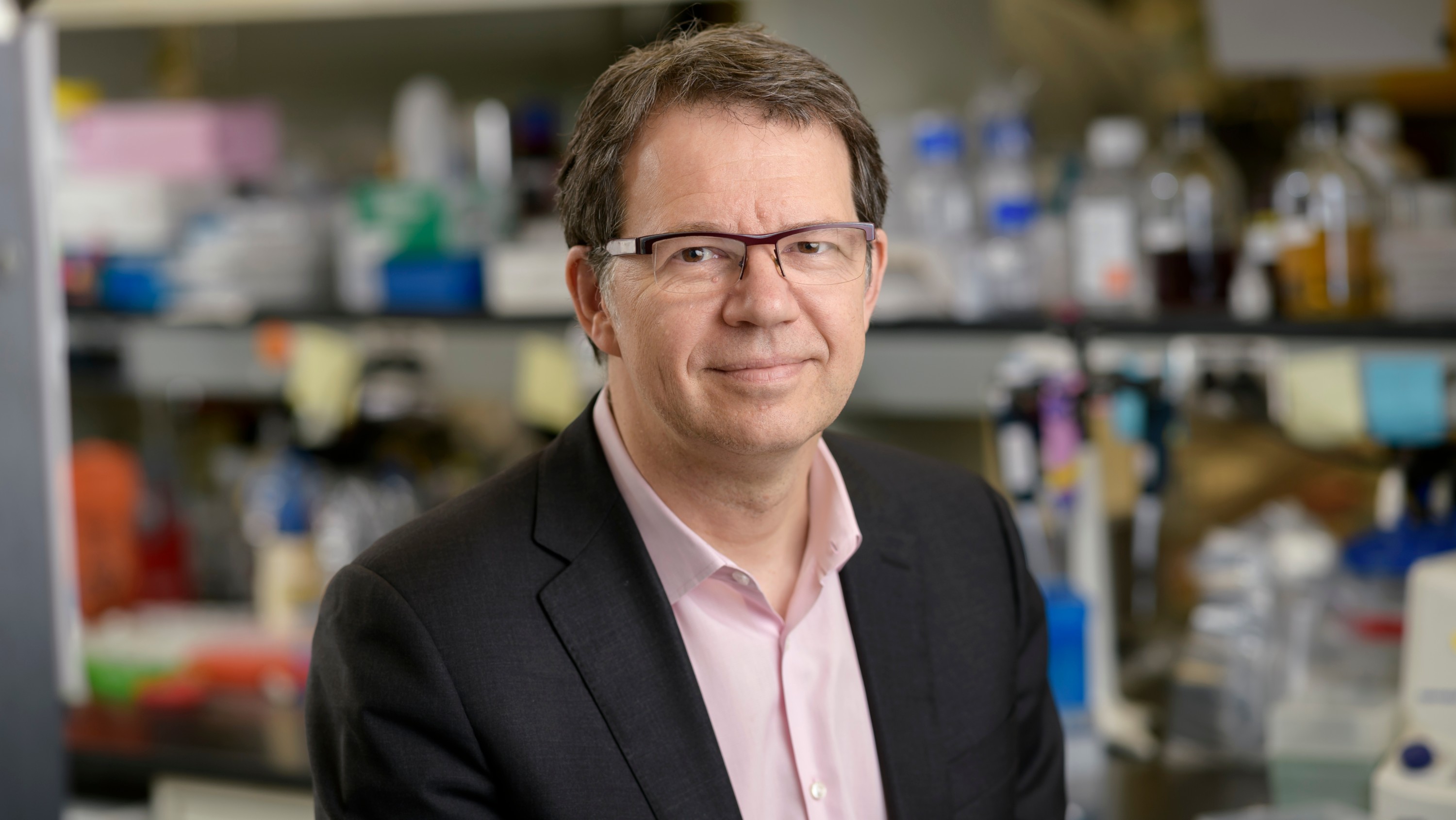UPDATE: On April 12, 2024, Michel Sadelain was awarded the Canada Gairdner International Award for seminal contributions to the conception, development and application of CD19-CAR T cell therapy for cancer. The Canada Gairdner International Awards are given annually to biomedical scientists who have made original contributions to medicine resulting in increased understanding of human biology and disease. Several researchers who have been named recipients have gone on to win the Nobel Prize in science or medicine.
Almost 35 years have passed since Michel Sadelain last sat at a microscope in a University of Alberta lab searching for ways to maybe one day harness the power of the immune system to fight cancer, but it was as clear then as it is now that greatness was just on the horizon.
“There are certain students you pick out and say, ‘That one’s going to go a long way,’” says Lorne Tyrrell, a longtime U of A Distinguished Professor, member of the Canadian Medical Hall of Fame, GSK Chair in Virology and leading hepatitis B researcher.
“He was a brilliant young man. I always thought he was going to win some major prizes.”
Today, Sadelain fulfilled that decades-old prophecy upon being awarded the 2024 Breakthrough Prize in Life Sciences in recognition of his discovery of cancer-fighting immunotherapy based on the genetic engineering of a patient’s own T cells.
“I wanted to share some of this recognition with the U of A, as my time there greatly contributed to shaping my relationship to science, stimulating my curiosity and instilling rigour but without stifling imagination,” says Sadelain.
An immunologist and director of the Center for Cell Engineering at Memorial Sloan Kettering Cancer Center in New York, Sadelain demonstrated that T cells — a type of white blood cell that helps your immune system — can be engineered to acquire the ability to recognize and destroy cancer cells.
These refurbished T cells, which he refers to as a “living drug,” are made by extracting a cancer patient’s T cells, inserting synthetic antigen receptors, which he named chimeric antigen receptors (CARs), and then reinfusing the cells.
“He really was the inventor of the CAR T cell,” says Tyrrell.
Sadelain, who hails from France, received an MD at the University of Paris in 1984 before attending the U of A, where he worked under renowned immunology professor Tom Wegmann and his vaunted Department of Immunology.
“Drs. Wegmann, Tyrrell, Singh and Green have remained mentors and role models ever since,” adds Sadelain.
After earning his PhD in immunology at the U of A in 1989, he left Edmonton to train as a postdoctoral fellow at the Massachusetts Institute of Technology in Cambridge, Mass., where he began his research on genetic engineering of immune cells.
In 1994, Sadelain went to New York, where he established programs on human hematopoietic stem cell and T cell engineering.
“As he was finishing his PhD, he had the idea that maybe he could make the immune system fight cancer,” says Tyrrell. “And he really did believe that’s what he could do.”
In 2003, Sadelain’s lab identified a protein-coding gene, CD19, as a target for CAR therapy in mice, and was the first to report on the effectiveness of such treatment in adults with relapsed, lymphoblastic leukemia. The treatment received FDA breakthrough designation in 2014 and full approval in 2017.
Sadelain’s work retooling the immune system is not only being employed in the fight against leukemia, lymphomas and a number of other cancers, including solid tumours, but is also being used to treat severe hemoglobinopathies, including sickle cell disease.
And while his life and work are centred in New York, the U of A and Edmonton are still a major focus of his life. His sister, brother and mother all have degrees from the U of A, with the latter two still calling Edmonton home. As well, Sadelain still advises on the work of Michael Chu, professor of oncology in the Faculty of Medicine & Dentistry, who is leading a project to manufacture and test locally produced CAR T cells for treating leukemia and lymphoma.
“Michel will win more prizes. It’s not uncommon that people who win the Breakthrough Prizes often make a trip to Stockholm to accept a Nobel Prize,” says Tyrrell.
“This award reflects very well on the education and mentorship he received here.”
At $3 million for each recipient, the Breakthrough Prizes are the richest awards in recognition of scientific advances. The annual prizes are given in mathematics, fundamental physics and life sciences, and are sponsored by a host of tech entrepreneurs including Mark Zuckerberg and Priscilla Chan of facebook and Sergey Brin, co-founder of Google.
Sadelain shares the award with fellow immunologist Carl June, a University of Pennsylvania researcher who developed and commercialized tisagenlecleucel, the first FDA-approved gene therapy for use in patients with B-cell acute lymphoblastic leukemia.
Fredrick Van Goor, who earned his PhD in biological sciences from the U of A in 1996, also received the Breakthrough Prize in Life Sciences for developing the first effective medications to treat the underlying cause of cystic fibrosis. In combination, the medications are effective for more than 90 per cent of patients, greatly improving the length and quality of their lives. Van Goor shares the prize with co-discoverers Sabine Hadida and Paul Negulescu.
